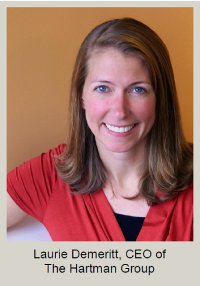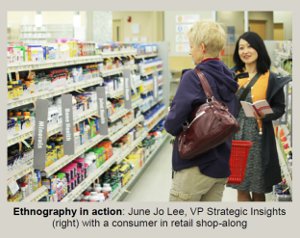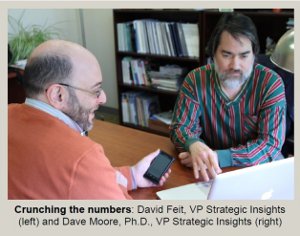From reading the organic tea leaves to turning questions on their heads: The Hartman Group at 25
 If a consumer insights company could choose any quarter century in which to study culture and consumer behavior, it would be hard pressed to find a more interesting 25 years than those just passed.
If a consumer insights company could choose any quarter century in which to study culture and consumer behavior, it would be hard pressed to find a more interesting 25 years than those just passed.
Since Harvey Hartman started this adventure in culture back in 1989, the dynamics of shopping and consuming have undergone more change than at any other time since the Industrial Revolution.
People have turned away from beloved brands and embraced new foods and experiences like never before. Despite busier schedules, they shop at more outlets to get precisely what they want. Organic has gone from a hippie backwater to a raging mainstream success, men have arrived as primary shoppers and smartphones have become gateways to exploration.
In this exciting new consumer-driven world, CEO Laurie Demeritt and several other Hartman Group veterans share where the company has been and what its trajectory – and that of its clients – says about what’s to come:
Blast from the late ‘90s
 Laurie remembers Expo East in Baltimore and the Organic Trade Show in the 1990s as pivotal for the organic and natural market, where The Hartman Group had staked an intellectual claim. “It was wild to see the energy, the small brands and large brands. Even Wal-Mart was there.”
Laurie remembers Expo East in Baltimore and the Organic Trade Show in the 1990s as pivotal for the organic and natural market, where The Hartman Group had staked an intellectual claim. “It was wild to see the energy, the small brands and large brands. Even Wal-Mart was there.”
Before ethnography was hot
Although studying the underlying cultural reasons for food and other trends is popular now, Demeritt remembers having to pitch its value to clients. “We’d talk to them about using ethnography to look at the whole rather than the individual,” she said.
Reading the organic tea leaves
Because The Hartman Group takes a cultural approach to research, it’s often been ahead of trends – predicting, for example, that organic would go mainstream years before others realized it. Even as few as five or six years ago, Demeritt recalls explaining to companies that consumers see organic as more about health than the environment. “They’d put pictures of the earth on products,” she said. “They assumed people wanted to save the world, but we saw the issue as moms wanting to feed their families better food.”
First to recognize a host of trends
Over the years, Demeritt recalls, The Hartman Group has predicted many major trends, including:
- The supplement rage, which changed the way people thought about health and wellness and which, like many trends, spun off outrageous fads, such as potato chips with St. John’s wort
- The realization that consumers often don’t change their weight management strategies, because weight perception is subjective and dependent on people’s social networks
- The fact that shoppers frequent all sorts of retailers based on various eating occasions, meaning there’s no single type of Whole Foods or Wal-Mart shopper
- Early recognition that the natural channel was a major source of trends, just as chefs and food trucks are now
- Shoppers are gravitating toward either end of the value versus premium product barbell and abandoning the middle
- The growing popularity of premium private label, a new trend related to the growth of premium overall, which Senior Vice President of Knowledge and Innovation James Richardson, Ph.D., a 12-year Hartman Group veteran, points out started with natural foods and continues with the recent popularization of local/global alterations to the American diet. “All along, we’ve understood that maximizing your opportunity in this space is a category-by-category strategic puzzle, one we’re proud to help clients solve every day.”
Consumers want ideas about food, not nutrition
 People can find nutritional information themselves. “What they want, even when it comes to health and wellness, is great food – including food that’s highly indulgent,” Demeritt said. CPG companies typically see that first and recognize that while health products are selling well, so are high-calorie snacks with nuts. Retailers have lagged, with some still placing their health and wellness products near the pharmacy, which makes them seem like medicine. Consumers want their food to be their medicine.
People can find nutritional information themselves. “What they want, even when it comes to health and wellness, is great food – including food that’s highly indulgent,” Demeritt said. CPG companies typically see that first and recognize that while health products are selling well, so are high-calorie snacks with nuts. Retailers have lagged, with some still placing their health and wellness products near the pharmacy, which makes them seem like medicine. Consumers want their food to be their medicine.
“One of Harvey [Hartman]’s first projects was for jeans made with organic cotton, back when sustainability was the new thing that was disrupting business as usual,” Vice President of Strategic Insights June Jo Lee, who has been with The Hartman Group for nine years, recalled. “We initially went down the path of natural products – hedging our bets on supplements and vitamins – and ended up in food, because food is the way most consumers can start participating in that larger dialogue. The road to health and wellness led us to food, where today, food is medicine.”
Seeing culture through a wider lens
Senior Marketing Manager David Wright, a 13-year Hartman Group veteran, remembers much of that journey.
“We initially thought product categories (supplements), behaviors (sustainable living) or classifications (organics) were critical to understanding cultural change, but we've realized over time that studying culture requires a wider lens,” he said.
“So now we work on a continuum, following consumers in motion, at home, in stores and in restaurants. Change is totally consumer driven, and to interpret it, you have to be really close to what people are doing.”
Unfortunately, industry still tends to leave consumers out of the picture, “so for us, communicating how consumers are changing remains an exciting challenge,” Wright said.
At-shelf decisions are irrelevant
It’s hard to break the traditional industry mindset that what people buy when they’re standing at the shelf is predictable. So many factors go into that decision that it cannot be accurately determined.
“Maybe they had a restaurant meal four weeks ago with lemongrass, so they buy the lemongrass flavor. Or maybe they saw it on the Food Network, or their children tried it at a friend’s house,” Demeritt said.
Rather than focus on the at-shelf decision, companies can spend time tracing the cultural reasons for purchase that many consumers find difficult to articulate.
Embrace the chaos
“Embrace that consumers are irrational,” Demeritt advised. “People will eat at McDonald’s even though they’re cooking with organic food. They used to smoke cigarettes after jogging.” It’s often about finding peace and joy, within themselves and within their families.
 Still, it’s possible to make some sense of the chaos, particularly if you meld survey and ethnographic data. Seeming irrationalities sometimes stem from survey results that generate findings about aspirational behavior – what people would do if everyday life didn’t intrude on them – rather than their typical behavior, explained Vice President of Strategic Insights David Moore, Ph.D.
Still, it’s possible to make some sense of the chaos, particularly if you meld survey and ethnographic data. Seeming irrationalities sometimes stem from survey results that generate findings about aspirational behavior – what people would do if everyday life didn’t intrude on them – rather than their typical behavior, explained Vice President of Strategic Insights David Moore, Ph.D.
“There’s a whole sociology of surveys; they can be misleading if taken at face value,” said Moore, who’s been at The Hartman Group for 15 years. “That’s the beauty of integrating survey data with our ethnographic experience: Seemingly irrational behavior can be explained and put in a larger context.”
Ethnography retread
After seeing the value in ethnographic research, some companies embraced it so completely that they hired their own ethnographers and, in some cases, sought ways to do ethnography online – which is more cost efficient but doesn’t always paint a complete picture of consumers’ lives.
In recent years, many companies have rethought that approach and want in-person, anthropologically based ethnography again from firms like The Hartman Group, which has experience with a greater depth and breadth of products and industries than most in-house ethnographers.
“We’re sponges. We don’t turn it off.”
Part of the wisdom that comes with experience includes knowing how to redirect clients when they’re not asking the right questions about consumer behavior.
“Sometimes, we turn their question on its head,” explained Melissa Abbott, a 10-year Hartman Group analyst who’s now Vice President of Retainer Services. “Take authenticity, for example. We heard consumers seven or eight years ago describing a desire for more authentic products and services.
“When we relayed that to clients, their reaction was sometimes to add the words ‘artisanal’ and ‘authentic’ to bags of conventional bread. But as Calvin Trillin says, ‘True authenticity means not having to pronounce how authentic you are.’
“It can be a challenge to explain that. We end up asking them about themselves: Who are you? What do you stand for? They have to be passionate about food to connect with people and to understand what we’re telling them about food culture and consumers and the competitive landscape. That’s where we shine. We’re sponges. We don’t turn it off.”
Turning toward innovation, strategy
“The beauty of understanding food culture the way anthropologists do is that it’s applicable worldwide – and it applies to innovation, ideation and strategy in ways that other market research does not,” Demeritt said.
As Shelley Balanko, Ph.D., Senior Vice President of Business Development and a 9-year Hartman Group veteran, put it, “We’ve matured, organically gaining new depth and breadth of knowledge in the food and beverage industry as more companies have sought us out.
“We’ve also gotten a lot more strategic,” she said. “In the early days, our work with clients was about positioning, marketing and communications. Now we’re answering a higher order of questions, about innovation and strategy, and they trust us because we have seasoning and longitudinal perspectives. Before we were a vendor or supplier, and now we’re seen more as a partner.”
